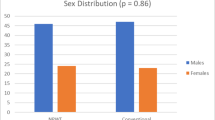Abstract
Background
Wound infections following vascular procedures occur in 1–7 % of patients and can lead to severe problems including amputation and death. There are no established treatment options for this complication. The aim of our study was to introduce continuous irrigation as a new treatment technique.
Methods
We retrospectively evaluated patients who had undergone bypass surgery involving the groin and had been treated with continuous irrigation because of deep wound infections. The irrigation solution was saline in all cases. The patients were additionally treated with antibiotics. The end point of the study was either complete wound healing or complications such as recurrent infection, amputation, or death.
Results
Wound complications occurred in 65 (15.3 %) of 424 operations. Overall, 20 patients (4.7 %) developed a deep wound infection involving prosthetic graft material. They were treated with continuous irrigation. Complete wound healing was achieved in 13 cases (65.0 %). One patient died. No amputations were necessary.
Conclusions
Based on our results, constant irrigation may be a therapeutic option in patients with deep wound infections. The main advantages of continuous irrigation over other treatments are ongoing bacterial reduction despite primary wound closure and the ability to measure the remaining colonization by microbiologic examination of the irrigation fluid.




Similar content being viewed by others
References
Darouiche R (2004) Treatment of infections associated with surgical implants. N Engl J Med 350:1422–1429
Herrera F, Kohanzadeh S, Nasseri Y et al (2009) Management of vascular graft infections with soft tissue flap coverage: improving limb salvage rates—a Veterans Affairs experience. Am Surg 75:877–881
Hasse B, Husmann L, Zinkernagel A et al (2013) Vascular graft infections: review article. Swiss Med Wkly 143:w13754
Williams I, Milling M, Shandall A (2003) Vascularised muscular flaps and arterial graft infection in the groin. Eur J Vasc Endovasc Surg 25:390–395
Bandyk D (2008) Vascular surgical site infection: risk factors and preventive measures. Semin Vasc Surg 21:119–123
Antonios V, Noel A, Steckelberg J et al (2006) Prosthetic vascular graft infection: a risk factor analysis using a case–control study. J Infect 53:49–55
Debus E (2012) Infektionen in der Gefäßchirurgie. Gefäßchirurgie 17:6–7
Cherry K, Roland C, Pairolero P et al (1992) Infected femorodistal bypass: is graft removal mandatory? J Vasc Surg 5:295–303
Szylagyi E, Smith R, Elliott J et al (1972) Infection in arterial reconstruction with synthetic grafts. Ann Surg 176:321–333
Samson R, Veith F, Janko G (1988) A modified classification and approach to the management of infections involving peripheral arterial prosthetic grafts. J Vasc Surg 8:147–153
Rieger H, Schoop W (2004) Allgemeine Maßnahmen bei Eingriffen am Gefäßsystem. In: Heberer, van Dongen (eds) Gefäßchirurgie. Springer, New York
Kogel H (2001) Möglichkeiten des Gefässersatzes und Einsatz von Nahtmaterialien. In: Hepp H, Kogel H (eds) Gefäßchirurgie. Urban und Schwarzenberg, Jena
Kellersmann R, Assadian O, Zegelman M (2012) Infections of vascular prostheses: options for prophylaxis. Gefässchirurgie 17:12–22
Mangram A, Horan T, Pearson M et al (1999) Guideline for prevention of surgical site infection. Infect Control Hosp Epidemiol 20:247–280
Calligaro K, Veith F, Yuan J et al (2003) Intra-abdominal aortic graft infection: complete or partial graft preservation in patients at very high risk. J Vasc Surg 38:1199–1205
Swain T, Calligar K, Dougherty M (2004) Management of infected aortic prosthetic grafts. Vasc Endovasc Surg 38:75–82
Saleem B, Meerwaldt R, Tielliu I et al (2010) Conservative treatment of vascular prosthetic graft infection is associated with high mortality. Am J Surg 200:47–52
Dosluoglu H, Loghmanee C, Lall P et al (2010) Management of early (<30 days) vascular groin infections using vacuum-assisted closure alone without muscle flap coverage in a consecutive patient series. J Vasc Surg 51:1160–1166
Mayer D, Hasse B, Koelliker J et al (2011) Long-term results of vascular graft and artery preserving treatment with negative pressure wound therapy in Szylagyi grade III infections justify a paradigm shift. Ann Surg 254:754–759
Svensson S, Monsen C, Kölbel T et al (2008) Predictors for outcome after vacuum assisted closure therapy of perivascular surgical site infections in the groin. Eur J Vasc Endovasc Surg 36:84–89
Taylor S, Weatherford D, Langan E et al (1996) Outcomes in the management of vascular prosthetic graft infections confined to the groin: a reappraisal. Ann Vasc Surg 10:117–122
Töpel I, Steinbauer M (2012) Biologische Sicherungsoperationen bei infektiösen Komplikationen in der Leiste. Gefässchirurgie 17:63–73
Kotsis T, Lioupis C (2007) Use of vacuum assisted closure in vascular graft infection confined to the groin. Acta Chir Belg 107:37–44
Karl T, Storck M (2012) Negative pressure wound therapy (NPWT). Gefässchirurgie 17:37–45
Colwell A, Donaldson M, Belkin M et al (2004) Management of early groin vascular bypass graft infections with sartorius and rectus femoris flaps. Ann Plast Surg 52:49–53
Dosluoglu H, Schimpf D, Schultz R et al (2005) Preservation of infected and exposed vascular grafts using vacuum assisted closure without muscle flap coverage. J Vasc Surg 42:989–992
Domingos C, Schulte S, Horsch S (2007) Vacuum assisted wound closure in postoperative periprosthetic groin infections: a new gold standard? J Cardiovasc Surg (Torino) 48:477–483
Berger P, de Bie D, Moll F et al (2012) Negative wound therapy on exposed prosthetic vascular grafts in the groin. J Vasc Surg 56:714–720
Author information
Authors and Affiliations
Corresponding author
Rights and permissions
About this article
Cite this article
Thermann, F., Wollert, U. Continuous Irrigation as a Therapeutic Option for Graft Infections of the Groin. World J Surg 38, 2589–2596 (2014). https://doi.org/10.1007/s00268-014-2650-8
Published:
Issue Date:
DOI: https://doi.org/10.1007/s00268-014-2650-8




